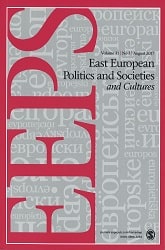Socialism, Synecdoche, and Tadeusz Konwicki’s Palace of Culture
Socialism, Synecdoche, and Tadeusz Konwicki’s Palace of Culture
Author(s): Ewa V. WampuszycSubject(s): Cultural history, Novel, Polish Literature, Post-War period (1950 - 1989), Film / Cinema / Cinematography, History of Art
Published by: SAGE Publications Ltd
Keywords: Tadeusz Konwicki; Palace of Culture; Warsaw; twentieth-century Polish Literature;
Summary/Abstract: Tadeusz Konwicki’s literary and cinematic treatment of the Palace of Culture and Science has had a significant influence on the perception and meaning of this Stalinist edifice. In his novels, Wniebowstąpienie [Ascension] (1967) and A Minor Apocalypse (1979), Konwicki uses the Palace as a means of critiquing communist ideology by adopting a Christian discourse that, in turn, invokes and questions the Polish Romantic messianic and martyrological tradition. In the 1989 film Lawa: Opowieść o “Dziadach” Adama Mickiewicza, Konwicki’s presentation of the Palace visually explodes into what seems to be the author’s “final” statement on the signification of the Palace. By examining the poetics of the Palace of Culture in Wniebowstąpienie, A Minor Apocalypse, and Lawa, this essay considers how over a period of twenty years Konwicki appropriated the meaning of the Palace by playing on the tension between the intended original signification of the building (as a Stalinist structure) and its function as a dynamic edifice that could be redefined in a localized (Polish), urban (Varsovian), and historical context.
Journal: East European Politics and Societies
- Issue Year: 27/2013
- Issue No: 02
- Page Range: 224-240
- Page Count: 17
- Language: English
- Content File-PDF

